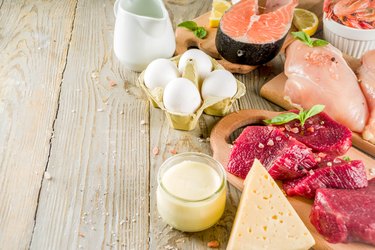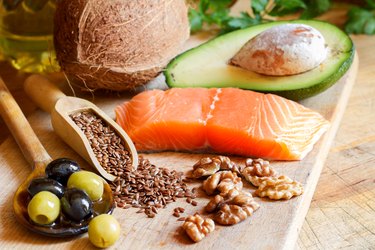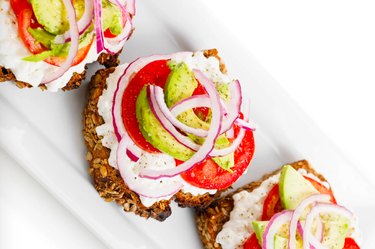
Lipids are fats. While fats were vilified a few decades ago, and many people avoided high-fat foods because they thought eating them would lead to weight gain, we now know better.
Our bodies need fat to keep our organs healthy. Fats store energy, so they become a reserve fuel source, per a May 2021 StatPearls report. Fats also help your body absorb and use vitamins A, D, E and K.
Video of the Day
Video of the Day
There are three main types of lipids:
- Unsaturated fats
- Saturated fats
- Trans fats
Some examples of lipids that are good for you include polyunsaturated fats and monounsaturated fats. These two types of unsaturated fats can help improve your blood cholesterol levels when eaten in moderation and used in place of saturated and trans fats, per the American Heart Association (AHA).
That brings us to saturated and trans fats: These contribute to higher cholesterol levels and are linked to an increased risk of heart disease, per the AHA. Saturated and trans fats are found in fast food, baked goods and fatty and processed red meats (like bacon).
The bottom line: Foods with lipids are not foods to avoid. But foods with lots of saturated fat, often called "bad fats," should be eaten sparingly. Look to this list of lipid foods to know what to add to your daily diet.
Tip
You should eat healthy fats every day, but you also need carbohydrates and proteins. When you see that a food has fat, it doesn’t always mean you should seek a low-fat version.
If you're looking to eat more healthy fats, try a Mediterranean-style eating plan, per the Mayo Clinic.
1. Fatty Meat and Poultry
Meat has lipids in the form of both saturated and unsaturated fats, depending on the type and cut.
Meats and meat products with the most lipids include:
- Beef fat
- Poultry skin
- Lard
- Bacon
- Ribs
Red meats — aka beef, pork and lamb — have more saturated fat than poultry and fish, according to the AHA. For example, a 3-ounce serving of steak has 26 percent of your daily value of saturated fat while a 3-ounce serving of salmon has just 5 percent of your daily value, per the USDA.
But that doesn't mean meat can't be part of a nutritious diet — simply choose lean cuts.
Tip
Lean cuts usually have the words “round,” “loin” or “sirloin” on the package, per the AHA.
2. Full-Fat Dairy
Dairy products with the most lipids include:
- Butter
- Ghee
- Heavy cream
- Full-fat cheeses and yogurts
If you can tolerate dairy, full-fat yogurt and cheese are a great way to get several nutrients. Full-fat dairy is high in saturated fat, but it can be eaten in moderation as part of a nutritious diet.
Most yogurts are full of probiotics, which are linked to better digestion, according to Harvard Health Publishing.
But note this: You're negating the benefits of yogurt if you choose one that's loaded with sugar. Stick to plain yogurt, and add your own fruit and natural sweeteners like honey. To add even more healthy fats, sprinkle nuts and seeds onto your yogurt.
3. Fatty Fish
Most fish have lots of lipids and protein, which your body needs. Fatty fish are the top source of omega-3 fats, a type of polyunsaturated fat that's linked to a reduced risk of heart disease and stroke, per the AHA.
The AHA recommends eating two weekly servings of fatty fish, such as:
- Salmon
- Mackerel
- Herring
- Anchovies
- Sardines
4. Seeds and Nuts
Many seeds and nuts are good sources of lipids and protein. Almonds, pecans, pistachios, macadamia nuts, walnuts, peanuts, flax seeds, chia seeds and pumpkin seeds are all high in unsaturated fats with ample amounts of protein. Walnuts are also a good source of omega-3s.
Aim for unsalted or lightly salted nuts for a nutritious snack. Limit them to a handful (about 1 ounce), and you'll give your body some good fats without too many calories. You can also add nuts to stir-fries and stews.
5. Plant Oils
Oils are a valuable source of lipids and plant-based oils have more good-for-you unsaturated fats, while animal-based fats are mostly made up of saturated fat.
Opt for these healthy cooking oils when you're meal prepping, per the AHA:
- Olive oil
- Canola oil
- Avocado oil
- Corn oil
- Peanut oil
- Safflower oil
- Soybean oil
- Sunflower oil
Try stir-frying vegetables in a heart-healthy oil to get that fiber (from the veggies) and healthy lipids (from the oil) at the same time.
6. Avocados
Avocados have a high ratio of unsaturated fat to saturated fat, per the USDA. They also have 50 percent of your daily recommended amount of fiber, which is linked to lower cholesterol.
Avocados are very nutritious, loaded with vitamin K, folate, vitamin C, potassium, vitamin B5 and vitamin B6. They have a lot of fat, but it's the healthy kind that will help you feel full.
7. Eggs
Eggs are another food with proteins and lipids. They don't have much saturated fat (1.6 grams or 8 percent of your daily value per large egg), but they do have dietary cholesterol — and for years, people were advised to limit eating eggs for this reason.
But it turns out that the cholesterol in eggs doesn't affect the cholesterol in the blood for most people, according to the Mayo Clinic.
- American Journal of Clinical Nutrition: Red Blood Cell MUFAs and Risk of Coronary Artery Disease in the Physicians' Health Study
- Statpearls: "Biochemistry, Lipids"
- AHA: "Fish and Omega-3 Fatty Acids"
- Harvard Health Publishing: "Your complete guide to choosing a yogurt to meet your needs"
- USDA: Choose My Plate
Was this article helpful?
150 Characters Max
0/150
Thank you for sharing!
Thank you for your feedback!


